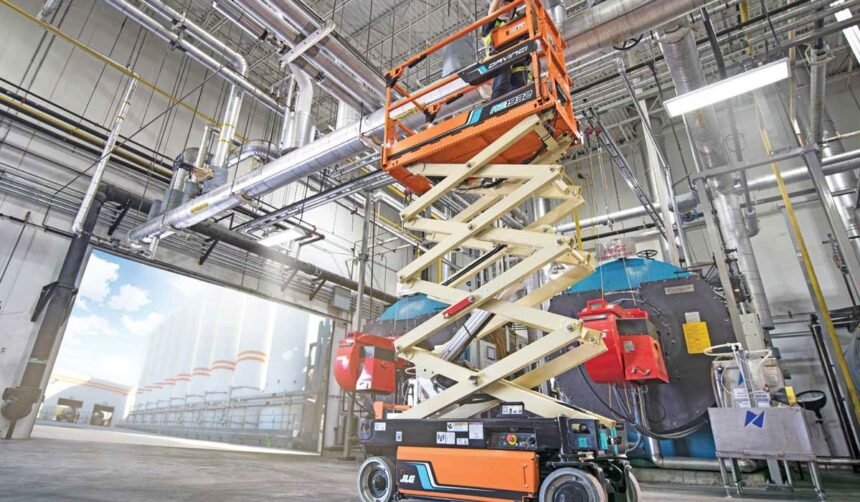In a world where speed, efficiency, and safety define the success of commercial and industrial projects, access to the right equipment is non-negotiable. Among the essential tools that elevate both productivity and safety standards are aerial work platforms, particularly scissor lifts. These vertical lifting machines have become staples in industries ranging from construction and warehousing to facility maintenance and event management. However, not every business requires permanent ownership of such equipment. This is where scissor lift rental presents a compelling, strategic alternative.
Renting a scissor lift not only meets short-term needs but also offers operational flexibility and financial efficiency. For businesses operating on tight schedules or within defined budgets, this rental model provides a practical solution for getting the job done without the burden of long-term commitments. In this article, we’ll dive deep into the benefits, applications, and best practices surrounding scissor lift rental, offering valuable insights for companies looking to optimize their workflow and workplace safety.
Understanding Scissor Lifts: Features and Functions
Scissor lifts are designed to elevate workers and equipment vertically using a series of crossed supports that fold in a crisscross pattern—resembling a pair of scissors. The platform atop the lift provides a stable and secure working surface, which is often surrounded by guardrails to prevent falls.
These machines are powered either electrically or through internal combustion engines, with different models tailored to various work environments. They are especially valued for their compactness, ease of operation, and capacity to carry heavy loads to elevated workspaces. Whether indoors or outdoors, scissor lifts help streamline operations by reducing the need for scaffolding or ladders, which can be less safe and more time-consuming.
Why Scissor Lift Rental Is a Smart Business Decision
Purchasing heavy machinery can represent a significant financial investment, especially for small to mid-sized businesses. When the need for such equipment is sporadic or seasonal, renting becomes a smarter and more agile solution.
1. Reduced Capital Expenditure
Owning a scissor lift requires an upfront investment that may not be justified for occasional use. Rental eliminates the need for a large capital outlay and redirects financial resources to other critical areas of the business.
2. No Maintenance Responsibility
Maintaining heavy machinery can be costly and time-consuming. When you rent, the responsibility for equipment servicing and repairs typically lies with the rental company. This removes unexpected expenses and keeps your operations focused and uninterrupted.
3. Access to Latest Models
Technology is constantly evolving, and so are the features of aerial lift equipment. Renting allows companies to access the latest, most efficient models without being tied to outdated technology. Updated safety systems, energy-efficient motors, and enhanced control features are just a few of the advantages.
4. Project-Specific Equipment
Different projects may require different types of lifts. Renting enables you to choose the perfect scissor lift based on height, load capacity, and terrain compatibility for each unique job—rather than relying on a single machine for every application.
5. Space Efficiency
Owning equipment requires dedicated space for storage. Rental eliminates the need to worry about where to keep machinery when it’s not in use, reducing overhead costs and freeing up valuable workspace.
Common Applications of Scissor Lifts
The versatility of scissor lifts makes them suitable for a wide range of industries. Here are a few examples where these machines prove indispensable:
- Construction: Installing ceilings, electrical systems, or HVAC units.
- Warehousing: Stocking and retrieving inventory from high shelves.
- Retail: Changing signage, adjusting lighting, or performing seasonal décor updates.
- Events: Hanging lights, banners, and audio-visual equipment at concerts or exhibitions.
- Facilities Management: Conducting repairs or maintenance on ceilings, walls, and utilities.
Their ability to offer stable and secure elevation makes them a favorite among safety-conscious professionals.
Selecting the Right Scissor Lift for Your Needs
Choosing the appropriate scissor lift rental begins with understanding your project’s requirements. Consider the following factors before making a rental decision:
- Height Requirements: How high does the platform need to reach? Most scissor lifts offer reach capabilities ranging from 15 to over 50 feet.
- Weight Capacity: Consider the number of workers and the weight of tools or materials that will be on the lift at any given time.
- Indoor vs. Outdoor Use: Electric scissor lifts are ideal for indoor use due to their quiet operation and zero emissions, while diesel-powered models are better suited for outdoor or rugged terrain.
- Surface Conditions: Will the lift operate on smooth concrete, gravel, or uneven ground? Rough terrain models offer better traction and stability for challenging surfaces.
Consulting with a reputable rental provider can help clarify these points and ensure you select the correct model.
The Importance of Safety in Scissor Lift Operation
Although scissor lifts are generally safe, adhering to proper usage protocols is crucial to prevent accidents. Rental providers often offer basic safety training or provide resources that outline operator responsibilities.
Key Safety Guidelines:
- Always Inspect Equipment Before Use: Look for structural damage, tire wear, or hydraulic leaks.
- Use Fall Protection When Necessary: Depending on the height and job requirements, personal fall arrest systems might be recommended.
- Follow Load Limits: Never exceed the manufacturer’s specified load capacity for people or tools.
- Operate on Stable Ground: Ensure the surface is level and firm before raising the platform.
- Keep Within Guardrails: Never stand on guardrails or lean too far outside the lift’s perimeter.
Some rental companies offer certification programs that provide workers with the skills and knowledge needed to operate scissor lifts safely and efficiently.
Cost Factors in Scissor Lift Rental
While renting a scissor lift is more affordable than buying, it’s important to understand the factors that can influence rental pricing:
- Model and Size: Larger, more specialized models typically cost more.
- Rental Duration: Most companies offer daily, weekly, and monthly rates—longer rentals often come with discounted pricing.
- Delivery and Pickup: Transportation fees may apply based on distance and equipment size.
- Insurance and Liability Waivers: Optional but recommended to protect against potential damage or accidents.
- Add-ons and Accessories: Some projects require additional attachments or safety equipment that may affect the overall cost.
Being transparent about your project’s needs will help rental providers offer the most accurate quote and avoid surprise charges.
How to Choose the Right Rental Partner
Selecting a dependable rental partner is just as crucial as choosing the right equipment. A trusted rental provider ensures the machinery is well-maintained, delivers on time, and offers technical support when needed.
Tri-Lift Industries is a leading name in the rental and supply of aerial lift equipment. Known for their diverse fleet and outstanding customer service, Tri-Lift Industries supports projects ranging from small repairs to large-scale commercial builds. Their commitment to safety, efficiency, and affordability makes them an ideal choice for businesses seeking reliable equipment and expert guidance.
What sets Tri-Lift Industries apart is their customer-centric approach—offering equipment that is meticulously maintained, competitively priced, and backed by a knowledgeable team ready to assist at every step. Whether you need help selecting the right lift or require onsite troubleshooting, their support ensures your job stays on track and within budget.
Sustainable Advantages of Renting vs. Buying
Beyond cost and convenience, renting equipment also aligns with environmentally sustainable business practices. When businesses choose rental over ownership, they:
- Reduce Redundancy: Shared equipment usage cuts down on unnecessary manufacturing.
- Encourage Efficient Use: Machines are kept in service more frequently and maintained regularly.
- Minimize Waste: Less idle equipment results in fewer obsolete machines ending up in landfills.
Incorporating rental strategies into your business model supports long-term environmental goals while enhancing operational efficiency.
Conclusion: Leveraging the Power of Rental for Better Results
Scissor lift rental in Cayce, SC isn’t just about filling a temporary need—it’s about unlocking smarter ways to work. From improved safety and reduced overhead to operational flexibility and access to the latest equipment, the benefits are clear.
By partnering with reliable providers such as Tri-Lift Industries, companies gain more than just a piece of machinery—they gain a dependable ally in completing projects safely, efficiently, and on budget. Whether you’re managing a facility, building a new structure, or organizing a major event, a rented scissor lift can provide the vertical advantage you need to succeed.
For more information Visit Timelymagazine








